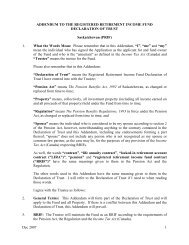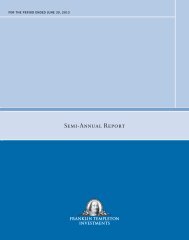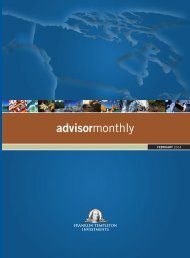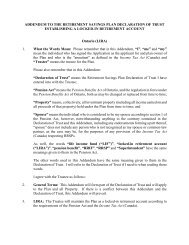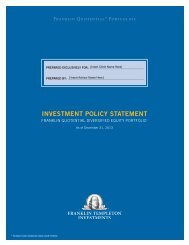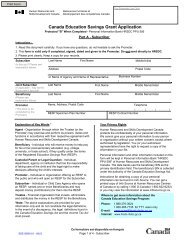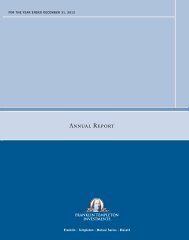ANNUAL REPORT - Franklin Templeton Investments
ANNUAL REPORT - Franklin Templeton Investments
ANNUAL REPORT - Franklin Templeton Investments
You also want an ePaper? Increase the reach of your titles
YUMPU automatically turns print PDFs into web optimized ePapers that Google loves.
<strong>Templeton</strong> Growth Fund, Ltd.<br />
NOTES TO FINANCIAL STATEMENTS<br />
For the periods ended April 30, 2013 and 2012 (Continued)<br />
10. Financial Risk Management (Continued)<br />
(e)<br />
Credit risk<br />
Credit risk is the risk that a counterparty to a financial instrument will fail to discharge an obligation or commitment that it has entered<br />
into with the Fund. This risk is generally lower if the issuer has a high credit rating from an independent credit rating agency, while<br />
the risk is generally higher if the issuer has a low credit rating or no credit rating. Where applicable, credit ratings have been disclosed<br />
at the end of the Statement of <strong>Investments</strong>.<br />
As at April 30, 2013 and April 30, 2012, the Fund had no significant investments in debt instruments and/or derivatives.<br />
All cash and trading transactions are carried out by banks rated A or higher by Standard & Poor’s as at April 30, 2013 and April 30,<br />
2012.<br />
(f)<br />
Fair value estimation<br />
The Fund classifies fair value measurements of investments held using a fair value hierarchy that reflects the significance of the<br />
inputs used in making the measurements. The fair value hierarchy has the following levels:<br />
• Level 1 — quoted prices (unadjusted) in active markets for identical assets or liabilities<br />
• Level 2 — inputs other than quoted prices included within Level 1 that are observable for the asset or liability, either directly<br />
(prices) or indirectly (derived from prices)<br />
• Level 3 — inputs for the asset or liability that are not based on observable market data (unobservable inputs)<br />
The determination of what constitutes “observable” requires significant judgment by the Manager. The Manager considers observable<br />
data to be market data that is readily available, regularly distributed or updated, reliable and verifiable, not proprietary, and provided<br />
by independent sources that are actively involved in the relevant market. Financial instruments that trade in markets that are not<br />
considered to be active but are valued based on quoted market prices, dealer quotations or alternative pricing sources supported by<br />
observable inputs are classified within Level 2. <strong>Investments</strong> classified within Level 3 have significant unobservable inputs, as they<br />
trade infrequently. These may include private equity and corporate debt securities. As observable prices are not available for these<br />
securities, the Manager has used valuation techniques to derive the fair value.<br />
The following tables show the classification of the Fund’s financial assets and liabilities measured at fair value as at April 30, 2013<br />
and 2012.<br />
April 30, 2013 April 30, 2012<br />
Level 1 Level 2 Level 3 Total Level 1 Level 2 Level 3 Total<br />
($000s) ($000s) ($000s) ($000s) ($000s) ($000s) ($000s) ($000s)<br />
Equities — long .............................. 1,392,283 — — 1,392,283 1,375,497 — — 1,375,497<br />
<strong>Investments</strong> in underlying fund ................. — — 10,743 10,743 — — 10,485 10,485<br />
Short-term securities ......................... — 6,500 — 6,500 — 20,700 — 20,700<br />
Total <strong>Investments</strong> ............................ 1,392,283 6,500 10,743 1,409,526 1,375,497 20,700 10,485 1,406,682<br />
Derivative assets ............................. — 31 — 31 — — — —<br />
Derivative liabilities ........................... — — — — — — — —<br />
16 <strong>Templeton</strong> Growth Fund, Ltd.



